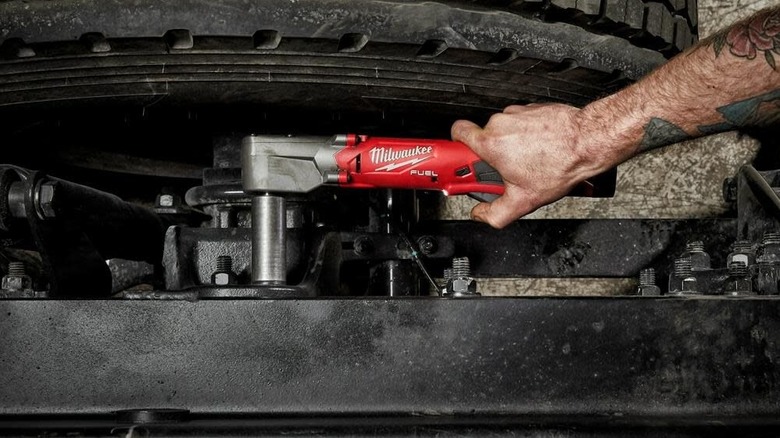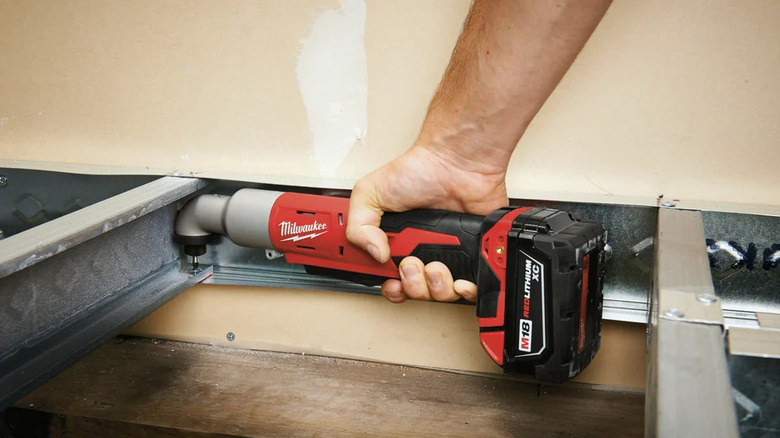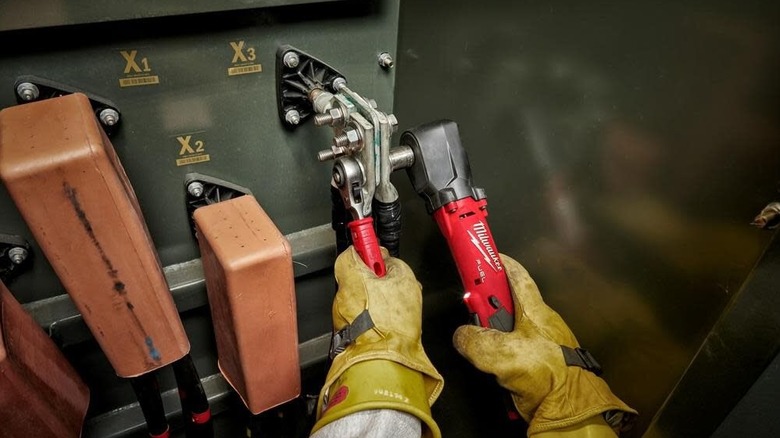Is Milwaukee's Right Angle Impact Drill Any Good? Here's What Users Say
We may receive a commission on purchases made from links.
Whether you're a car owner dipping your feet into automotive repair, an amateur furniture-maker installing drawers, or are working in construction, a right angle impact drill can change your life. Milwaukee fans have their pick between right angle impact drills from its M12 and M18 battery systems. Typically, you're going to get more bang for your buck if you simply buy into the battery system you're already invested in. After all, one of the big reasons we purchase tools from brands like Milwaukee is the interchangeability.
If you're buying a system for the first time, it's smart to evaluate the broader portfolio of compatible products. But if you're invested in both, you might be on the fence about which tool is best for you. To help you decide, we've examined the characteristics of both offers, including ergonomics, speed, and torque. Skip to the end wherein we discuss our methodology for more details.
At Home Depot, the M18 ¼-inch Right Angle Impact Driver goes for $179. Meanwhile, the M12 FUEL 1/2-inch model with Pin Detent is $229 at the same retailer. Apart from being cordless, both models have variable-speed triggers and can go forwards and backwards. With small heads that are designed to fit into tight spots, they also work in areas that regular impact drivers can't reach, plus they share company's standard five-year limited warranty. As a shared caveat, both aren't compatible with the Milwaukee One-Key tool registration system, but how are they actually different?
How the M12 and M18 Right Angle Impact Drills compare
In general, the M18 is designed to be the larger, more powerful battery, which means a longer run time. Despite this, the M12 wins by a margin with a maximum RPM of 3,000 RPM, while the M18 can reach 2,250. As for its torque, the M12 FUEL option takes the cake, generating up to 220 ft-lbs with Powerstate Brushless Motor while also featuring an auto shut-off and bolt-removal mode. Given this, it's not surprising that it makes a great addition to any Milwaukee cordless on-the-go tool kit. As for the M18, it has 2-speed drive-control with a maximum torque of 675 in-lbs (or about 56.25 ft-lbs), about a quarter of the M12's capabilities.
Without the battery, the M12 FUEL ½-inch model weighs around 2.8 pounds, which isn't significantly heavier than the 2.7 pound M18 FUEL's ¼-inch. For perspective, both weigh little more than your average hammer. It's important to note that high capacity M18 batteries, like the M18 REDLITHIUM High-Output HD 12Ah, are 3.3 lbs. As for access based on the head size, the M12 has a slightly larger head profile at 2.2-inches, whereas the M18's is about 1.7-inches with an option for an extended paddle switch. Regardless of what you add to your Milwaukee portfolio, existing reviews of its right angle impact drills are promising, with both models netting an average rating of 4 stars.
What users have to say about the M12 and M18 Right Angle Impact Drills
As of writing, the M12 FUEL ⅜-inch Right Angle Impact Wrench with Friction Ring has an average of 4.6 stars from more than 310 people on the Milwaukee website, while the M12 FUEL 1/2-inch model has generated the same rating from over 520 Amazon buyers. Customers were surprised by its power and how well it worked on getting tight and hard-to-reach bolts. Likewise, many have mentioned using it on automobiles with flying colors. That said, one professional plumber commented that while it significantly reduced their working time, it wasn't ideal for every job.
Alternatively, the M18 model has a 4.4 star average rating from 16 people on Milwaukee's website. It's fared better on Home Depot, wherein more than 130 buyers have rated it 4.6 stars. Among its issues, people found it too heavy and experienced problems with the rubber seal. Additionally, one user mentioned that the M12 performed better.
In reality, both Milwaukee impact right angle impact drills will likely suffice most work needs. Despite their differing price points, most users seem satisfied with their purchase. Given this, the average homeowner will probably not notice significant differences in performance. But for professionals, you'll want to consider the impact of variations in weight, head size, RPM, and torque. That said, the tools that run on M18 batteries do tend to have a longer battery life, so they're ideal for longer and continuous use.
Methodology
With so many right angle drill options from prominent tool manufacturers, we went into detail about what makes Milwaukee's offers stand out. Since the brand offers it in multiple models across two different battery systems, we looked deep into the specific characteristics of each variant. We highlighted significant features that may move the needle including maximum RPM and torque while mentioning a few things that are good to know but not necessarily deal breakers, such as head sizes and weight. Lastly, we took note of how each respective battery system affects its overall usage time.
To help further evaluate Milwaukee's right angle drills, we looked at real user feedback from the brand's official website, as well as ratings on other major online retail platforms like Amazon and Home Depot. Since both fared similarly in terms of average ratings, we discussed what specific components tend to have issues and what you should watch out for, especially if they could be a potential source of concern. Upon investigating reviews, we not only listed what people liked or didn't like, but also shared what type of users felt satisfied with it and the personal or professional applications they worked best for.



